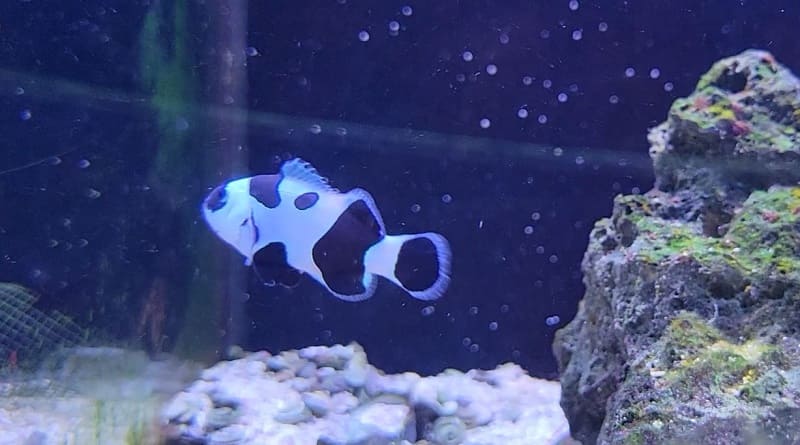The captivating Black Stormtrooper Clownfish, with its mesmerizing white pattern, is a choice for any marine aquarium. To ensure the happiness and well-being of these fish it is crucial to provide them with the care and an environment that suits their needs. Here is a detailed guide, on how to take care of Black Stormtrooper Clownfish in your aquarium;
1. Tank Size and Setup:
- The recommended tank size for a single pair of Black Stormtrooper Clownfish is at least 20 gallons. Larger tanks can accommodate more individuals or other compatible fish species.
- Create an environment that mimics their natural habitat by using fine-grain sand as substrate and providing hiding spots using live rocks or artificial decorations. Ensure the decor won’t harm the fish or damage their delicate fins.
- Install a quality filtration system to maintain water cleanliness and stability. Adequate water circulation is essential for oxygenation and waste removal.
2. Water Parameters:
- Maintain a stable and suitable water temperature between 75°F to 82°F (24°C to 28°C) to provide a comfortable environment for the clownfish.
- Keep the pH level within the range of 8.1 to 8.4. Regularly test water parameters and perform water changes as necessary to avoid harmful fluctuations.
- Monitor salinity levels and aim for a specific gravity of 1.020 to 1.025.
3. Lighting:
- Provide moderate lighting in the aquarium. Excessive brightness can stress the fish and encourage unwanted algae growth.
- Consider using a timer for the lights to mimic natural day and night cycles, which can promote healthy behavior in the fish.
4. Companions and Tankmates:
- Black Stormtrooper Clownfish can be territorial, so it’s best to keep only one pair in the tank or multiple individuals of the same species.
- If you wish to keep other fish with the clownfish, choose peaceful species that are known to be compatible and won’t bully or harm them. Small community fish like Gobies, Damsels, and certain Wrasse can make suitable tankmates.
5. Feeding and Nutrition:
- These clownfish are omnivorous, meaning they eat both meaty and plant-based foods in the wild.
- Offer high-quality commercial foods like flake or pellet foods specifically formulated for marine fish. These should be the staple diet.
- Provide variety by supplementing their diet with frozen foods like brine shrimp, mysis shrimp, and chopped seafood.
- Include algae-based foods or seaweed sheets in their diet to mimic their natural feeding habits.
6. Water Quality and Maintenance:
- Regularly test the water quality using a reliable test kit to monitor ammonia, nitrite, nitrate, and pH levels. This helps you identify and address any issues promptly.
- Perform regular water changes (around 10-20% of the tank volume) to remove accumulated nitrates and other impurities and maintain water quality.
- Keep the aquarium clean by siphoning debris and uneaten food from the substrate.
7. Health and Disease Prevention:
- Observe the clownfish daily to ensure they are active, have good appetite, and show no signs of distress or disease.
- Quarantine any new fish or corals before introducing them to the main tank to prevent the spread of potential diseases.
- If you notice any signs of illness or abnormal behavior, consult a knowledgeable aquarium professional or veterinarian with experience in marine fish.
8. Breeding (Optional):
- Breeding Black Stormtrooper Clownfish can be an exciting venture for experienced aquarists. However, it requires careful planning and dedication.
- Provide a suitable environment for the breeding pair, including a flat surface for egg-laying, such as a large flat rock or ceramic tile.
- Once the eggs are laid, the male will diligently care for them until they hatch, and the fry will need specialized food, such as rotifers and newly hatched brine shrimp, for their early development.
By following these care guidelines, you can provide a safe, healthy, and enriching environment for your Black Stormtrooper Clownfish, ensuring they thrive and continue to enchant and captivate with their striking beauty and playful personalities. Remember that responsible fishkeeping involves ongoing learning and commitment to the well-being of your aquatic companions. Enjoy the journey as you explore the wonders of the marine world through these delightful fish!

